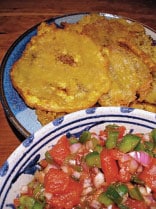
| Island-hopping from Cartagena in 2006, we’d sailed Ithaka, our Shearwater 39, downwind along Colombia’s rugged northern coast, tucking into protected harbors on the mainland and hiding from the strong prevailing easterlies behind lush tropical islands. When Douglas and I made landfall at sleepy little Isla Fuerte, off the northwest coast of Colombia, the island didn’t seem like much to write home about. Beware first impressions.
There were small, paved footpaths between tiny, concrete houses and bamboo huts. There was a church and three little tiendas, each selling the same assortment of tomato paste, rice, sugar, cooking oil, and sardines. As I walked back to the dinghy on that first day of poking around, a raisin of an old woman with no teeth called over, asking in rapid-fire Spanish if I wanted to buy aciete de tiberon-shark oil. “Why do you take such a thing?” I asked. “For asthma and grippe,” she said, baring a smile of gums. “Oh, dear,” I said. “Thank you, but I don’t need it.”
“Gracias a Dios,” she said, blessing herself.
Wandering around Fuerte, dramas unfolded: A fishing boat wrecked against the reef, and the islanders made futile attempts to save it while distraught fishermen looked on. Children followed us everywhere holding our hands. And there was our visit to the school, where we were welcomed like royalty by Rodolfo Rodrigues, who teaches philosophy, which Colombian 10th and 11th graders are required to study for two hours twice a week.
On our second day on Fuerte, a man named Alberto rowed his canoe out to Ithaka, asking if we’d like him to cook us dinner ashore for the equivalent of US$4. He offered chicken and patacones-delicious, flattened plantain pancakes-along with salad, French fries, and dessert, all served on the veranda of the beach house of which he was caretaker. He said the owner, who lived in Medellin, had given him permission to make a little extra money. That evening, we dinghied to the house and were surprised to find Colombian and German friends of the owner staying there. It’d been their idea to invite us. So began what would become an evening ritual: dinner at the house, followed by salsa music. Margarita and Angela led the dancing, teaching us moves my body hadn’t known were possible. Every morning after that, I joined the girls on the veranda for Latin aerobics led by Angela, a physical therapist with a truck-stopping figure.
Margarita, a painter in Medellin, spent one morning teaching us watercolor techniques and another demonstrating how to make patacones. We’d come to love eating this very simple but delectable side dish. And this is how our days on Fuerte unfolded: chatting away in Spanglish and taking our new friends sailing, visiting the school, painting, and dancing. Isla Fuerte, an island we’d originally thought of as a drop by, held us enthralled for 10 days, inspiring some of our strongest and sweetest memories of Colombia.
Patacones
6 firm, green plantains*
1/4 cup vegetable oil
Salt, to taste
* If the plantains are too ripe, the increased sugar content intensifies the sweet flavor.
Peel plantains and slice widthwise into three or four pieces (each about two inches long). Boil pieces in water for 5 to 20 minutes to soften, depending on their ripeness. Remove plantain pieces, drain, and pat dry. Place one piece between two sheets of plastic wrap. Place a cutting board on the plantain and press down until it’s a pancake that’s about an eighth of an inch thick. Peel off plastic and fry pancake in very hot oil for about 3 minutes per side or until golden brown. Place on a plate and sprinkle with salt, preferably kosher or sea salt. Repeat this process until all pieces are browned. Drain on paper towels. Serve two or three per person. Patacones are scrumptious when accompanied by salsa, jazzed up with hot sauce, and backed with a cold beer.







